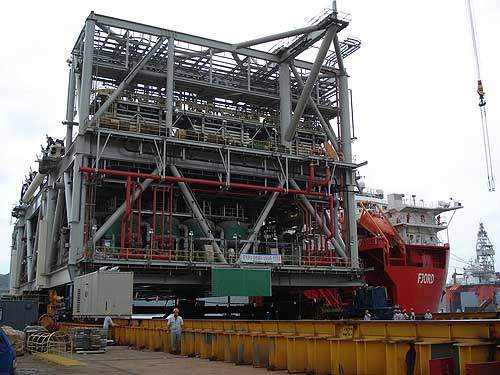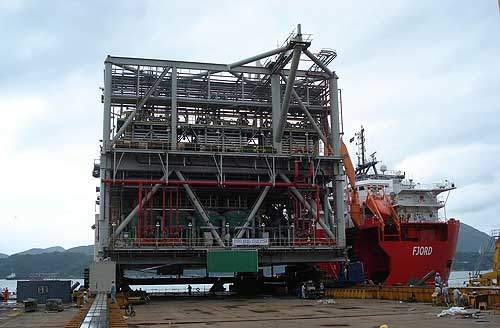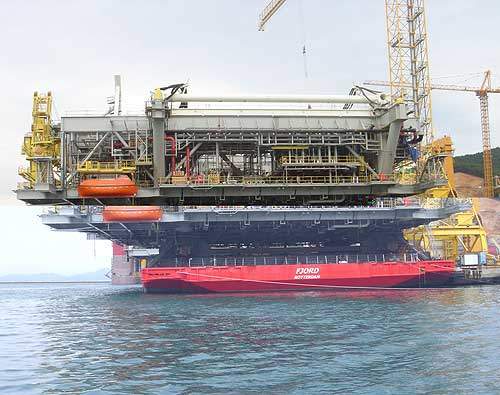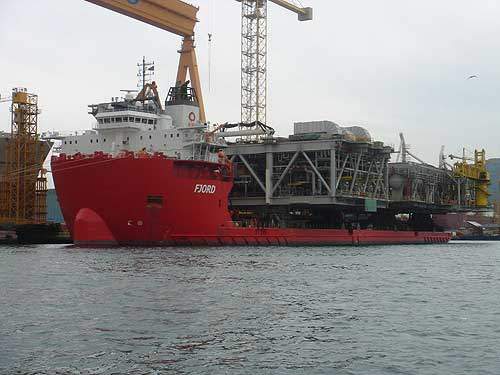The Tombua-Landana project covers the development of the Tombua and Landana fields, which are situated 80km offshore Angola in West Africa. The project lies at a water depth of 1,200ft in the eastern section of block 14.
Chevron is the operator of the field with a 31% interest. Partners include Sonangol (20%), Eni (20%), Total (20%) and Galp Energia (9%).
The field came onstream in September 2009 and was developed with an investment of $3.8bn.
Tombua-Landana discoveries
The Tombua field was discovered in 1997 by the Tombua-1 well. The Landana field was discovered in 2001 by the 14-6X / 6XST-1 well.
The Tombua-Landana reservoirs are of the Lower Miocene CN3 age and are made of high-quality sands deposited in a series of structural and stratigraphic traps. The fields are estimated to contain recoverable resources of 350 million barrels.
Development of the Tombua and Landana fields
In June 2006, first oil was achieved from the Landana North-1 subsea well, which was connected to the Benguela Belize-Lobito Tomboco (BBLT) compliant piled tower (CPT). The well was drilled to gather reservoir information and plan the development of the fields.
A total of 11 reservoirs are to be developed as part of the project. Most of these reservoirs are at their bubble points, therefore, pressure maintenance is essential to ensure maximum recovery.
The project received government approval in November 2006 and in 2007, pre-drilling activities at the fields began. A total of 46 wells were drilled and tied-back to the Tombua Landana CPT. A tender-assisted drilling (TAD) rig is moored near the production platform to carry out drilling operations.
The project was designed to ensure zero gas flaring and zero discharge of produced water. The produced natural gas is processed and stored in an existing reservoir on block O until the Angola Liquefied Natural Gas project being built in Soyo is ready. The produced water is recycled and reinjected into the reservoirs.
Tombua Landana platform
The Tombua-Landana platform weighs 76,000t and includes an integrated deck with production facilities. The platform is 1,554ft high and supported by a 56,400t four-legged CPT. The CPT is one of the world’s biggest man-made structures and is fixed onto the seafloor by 12 foundation piles.
An accommodation facility for 120 people is also part of the platform. The platform has 38 well slots and has a capacity of 130,000bpd of oil and 210MMcf per day of gas. It has a water-injection capacity of 310,000bpd.
Subsea system and pipeline
The subsea system for the Tombua-Landana fields comprises two subsea manifolds. One manifold is a subsea collection centre for production and the second is for water injection.
Two export pipelines were installed to export of gas and oil from the fields.
The gas export pipeline is 31km long and 14in in diameter. It is connected to the BBLT gas export pipeline through a subsea piggable wye in 570ft of water.
The oil export pipeline is 26km long and has a diameter of 18in. It is connected to the BBLT oil export pipeline through a subsea piggable wye in 380ft of water.
Contracts for the Tombua-Landana fields
KBR provided the front end engineering services for the Tombua-Landana project. The front end engineering design and project management services for the CPT were provided by Mustang Engineering.
Daewoo Shipbuilding & Marine Engineering (DSME) was awarded a $1.27bn contract for building the platform. DSME subcontracted Gulf Marine Fabricators for fabrication of the top and bottom sections of the CPT.
Heerema Fabrication Group was responsible for the fabrication of the base structure and foundation piles of the CPT. The foundation piles are the longest ever to be installed in the world, measuring 624ft.
The accommodation facility of the platform was manufactured by Delta Engineering.
Sonamet was responsible for the manufacture and supply of the platform’s drilling template.
InterMoor was awarded the contract for providing a mobile offshore drilling unit to pre-drill the platform wells. The company also supplied eight preset mooring anchors for the TAD rig and a 60ft suction follower.
Seadrill was contracted to supply the TAD rig in August 2006. Gusto MSC supplied telescopic gangways for the CPT.
Fairstar Heavy Transport transported the topside modules of the platform. Fairstar used its heavy transport ship Fjord to transport the modules from South Korea to Angola.
In September 2006, Subsea 7 was contracted for the supply and installation of tie-back facilities including manifolds, flowlines, jumpers and umbilicals.
Vetco Gray supplied subsea equipment for the project, which included a tree system, manifolds, and well jumpers and production control systems.
Acergy West Africa installed the oil and gas export pipeline.











